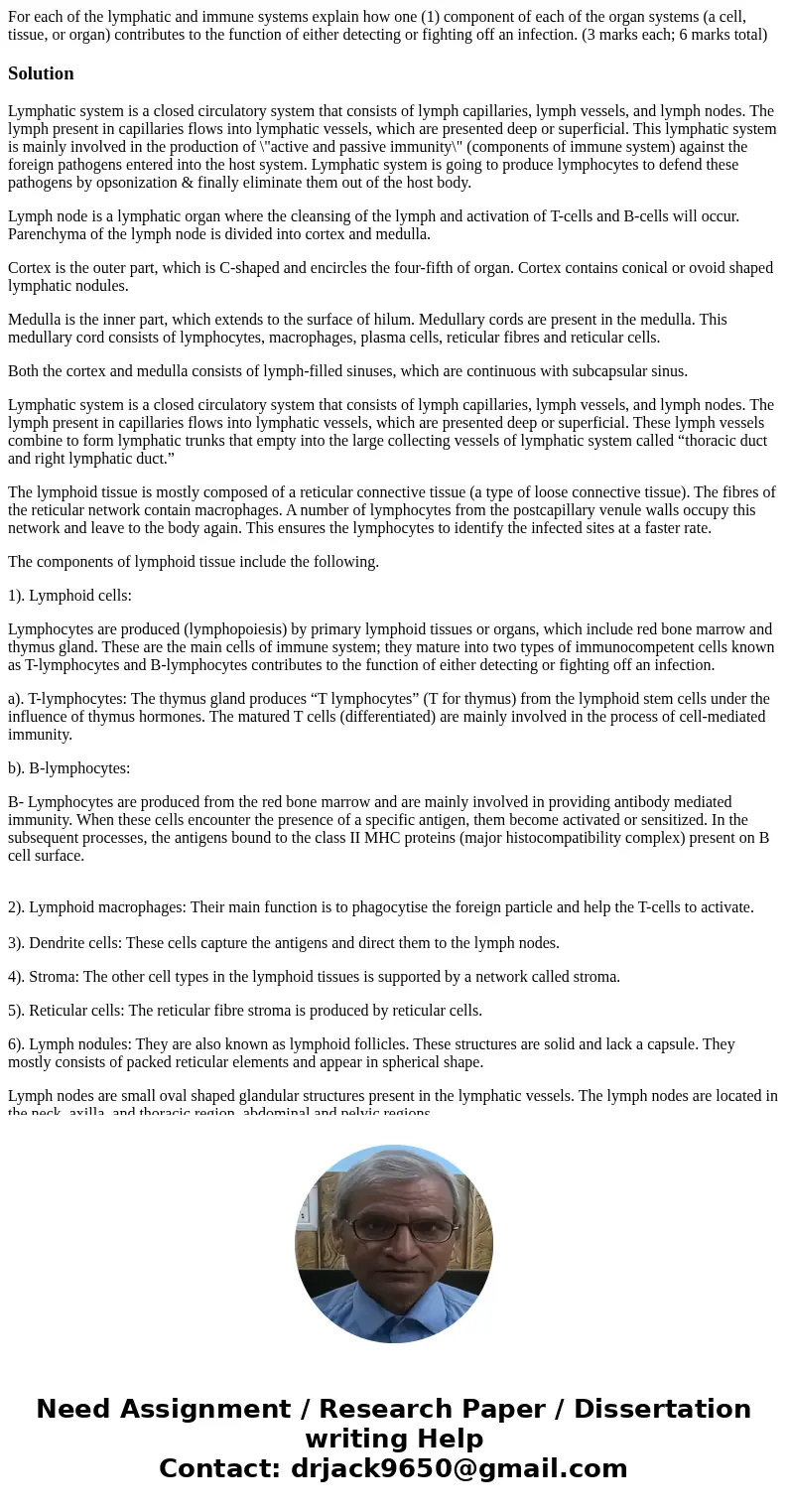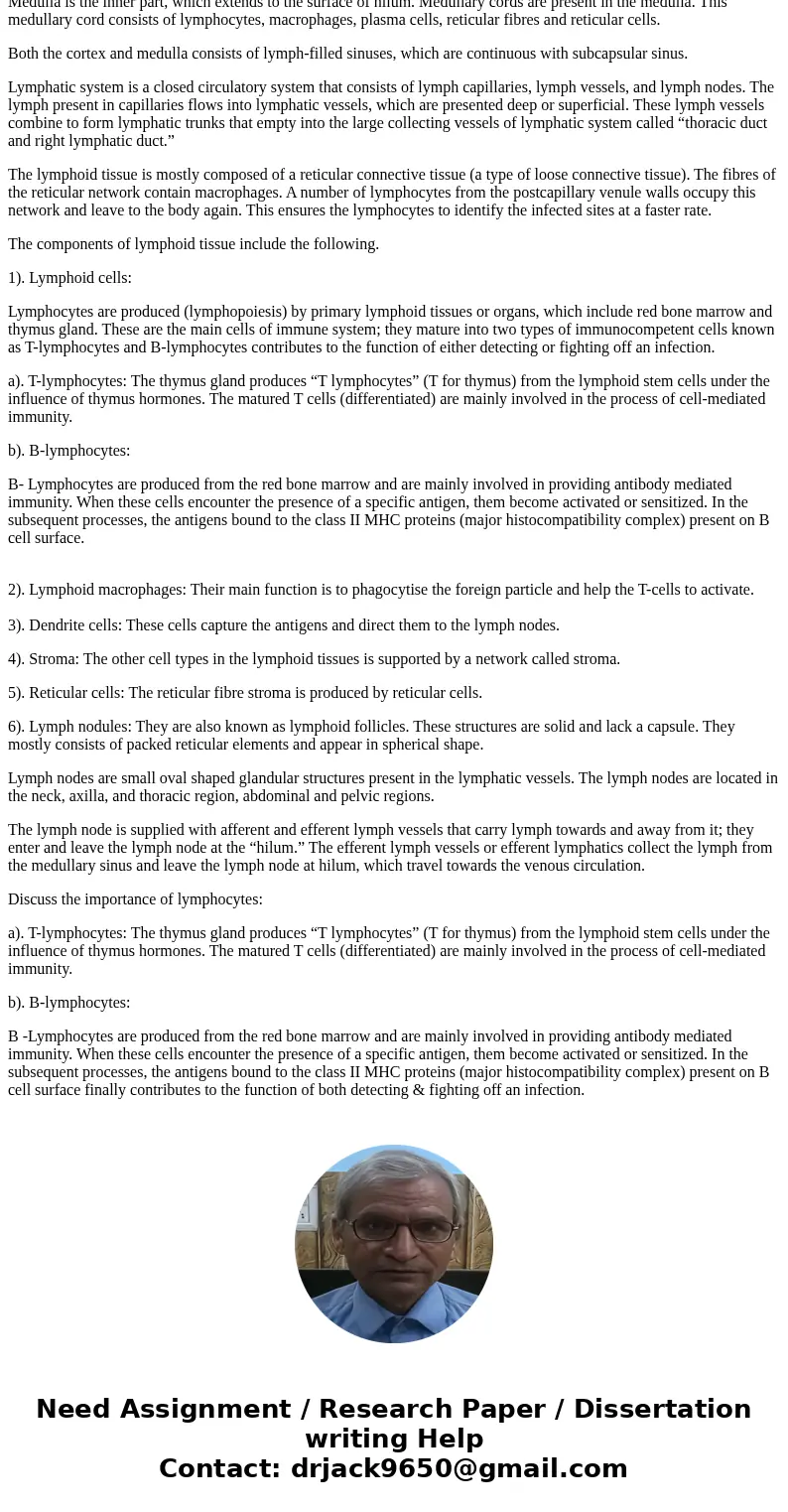For each of the lymphatic and immune systems explain how one
For each of the lymphatic and immune systems explain how one (1) component of each of the organ systems (a cell, tissue, or organ) contributes to the function of either detecting or fighting off an infection. (3 marks each; 6 marks total)
Solution
Lymphatic system is a closed circulatory system that consists of lymph capillaries, lymph vessels, and lymph nodes. The lymph present in capillaries flows into lymphatic vessels, which are presented deep or superficial. This lymphatic system is mainly involved in the production of \"active and passive immunity\" (components of immune system) against the foreign pathogens entered into the host system. Lymphatic system is going to produce lymphocytes to defend these pathogens by opsonization & finally eliminate them out of the host body.
Lymph node is a lymphatic organ where the cleansing of the lymph and activation of T-cells and B-cells will occur. Parenchyma of the lymph node is divided into cortex and medulla.
Cortex is the outer part, which is C-shaped and encircles the four-fifth of organ. Cortex contains conical or ovoid shaped lymphatic nodules.
Medulla is the inner part, which extends to the surface of hilum. Medullary cords are present in the medulla. This medullary cord consists of lymphocytes, macrophages, plasma cells, reticular fibres and reticular cells.
Both the cortex and medulla consists of lymph-filled sinuses, which are continuous with subcapsular sinus.
Lymphatic system is a closed circulatory system that consists of lymph capillaries, lymph vessels, and lymph nodes. The lymph present in capillaries flows into lymphatic vessels, which are presented deep or superficial. These lymph vessels combine to form lymphatic trunks that empty into the large collecting vessels of lymphatic system called “thoracic duct and right lymphatic duct.”
The lymphoid tissue is mostly composed of a reticular connective tissue (a type of loose connective tissue). The fibres of the reticular network contain macrophages. A number of lymphocytes from the postcapillary venule walls occupy this network and leave to the body again. This ensures the lymphocytes to identify the infected sites at a faster rate.
The components of lymphoid tissue include the following.
1). Lymphoid cells:
Lymphocytes are produced (lymphopoiesis) by primary lymphoid tissues or organs, which include red bone marrow and thymus gland. These are the main cells of immune system; they mature into two types of immunocompetent cells known as T-lymphocytes and B-lymphocytes contributes to the function of either detecting or fighting off an infection.
a). T-lymphocytes: The thymus gland produces “T lymphocytes” (T for thymus) from the lymphoid stem cells under the influence of thymus hormones. The matured T cells (differentiated) are mainly involved in the process of cell-mediated immunity.
b). B-lymphocytes:
B- Lymphocytes are produced from the red bone marrow and are mainly involved in providing antibody mediated immunity. When these cells encounter the presence of a specific antigen, them become activated or sensitized. In the subsequent processes, the antigens bound to the class II MHC proteins (major histocompatibility complex) present on B cell surface.
2). Lymphoid macrophages: Their main function is to phagocytise the foreign particle and help the T-cells to activate.
3). Dendrite cells: These cells capture the antigens and direct them to the lymph nodes.
4). Stroma: The other cell types in the lymphoid tissues is supported by a network called stroma.
5). Reticular cells: The reticular fibre stroma is produced by reticular cells.
6). Lymph nodules: They are also known as lymphoid follicles. These structures are solid and lack a capsule. They mostly consists of packed reticular elements and appear in spherical shape.
Lymph nodes are small oval shaped glandular structures present in the lymphatic vessels. The lymph nodes are located in the neck, axilla, and thoracic region, abdominal and pelvic regions.
The lymph node is supplied with afferent and efferent lymph vessels that carry lymph towards and away from it; they enter and leave the lymph node at the “hilum.” The efferent lymph vessels or efferent lymphatics collect the lymph from the medullary sinus and leave the lymph node at hilum, which travel towards the venous circulation.
Discuss the importance of lymphocytes:
a). T-lymphocytes: The thymus gland produces “T lymphocytes” (T for thymus) from the lymphoid stem cells under the influence of thymus hormones. The matured T cells (differentiated) are mainly involved in the process of cell-mediated immunity.
b). B-lymphocytes:
B -Lymphocytes are produced from the red bone marrow and are mainly involved in providing antibody mediated immunity. When these cells encounter the presence of a specific antigen, them become activated or sensitized. In the subsequent processes, the antigens bound to the class II MHC proteins (major histocompatibility complex) present on B cell surface finally contributes to the function of both detecting & fighting off an infection.


 Homework Sourse
Homework Sourse